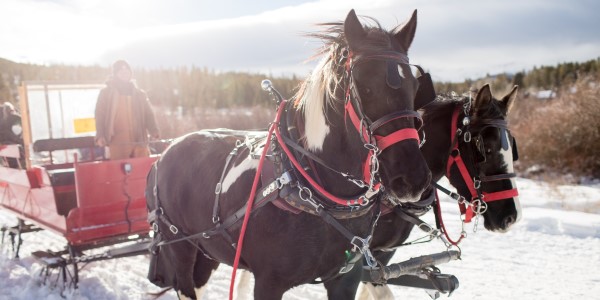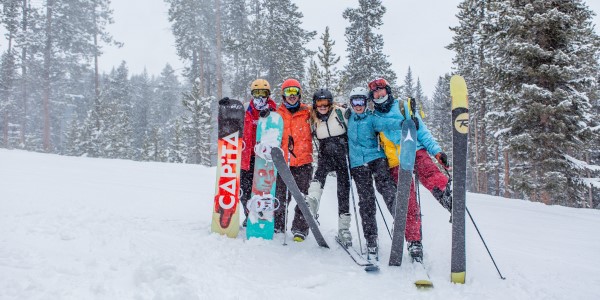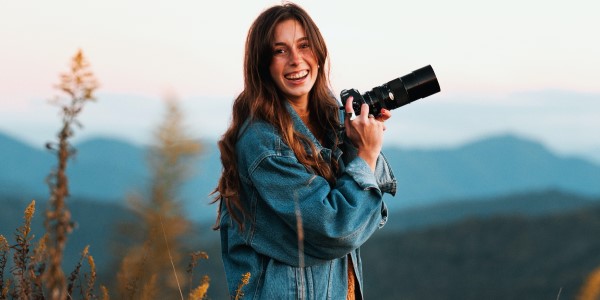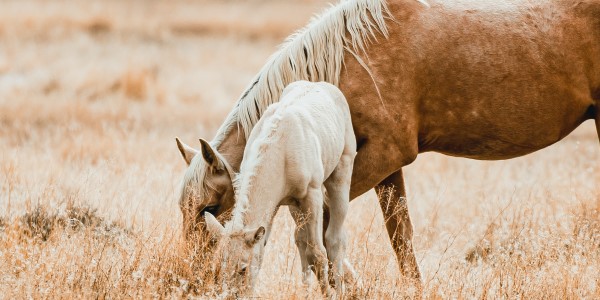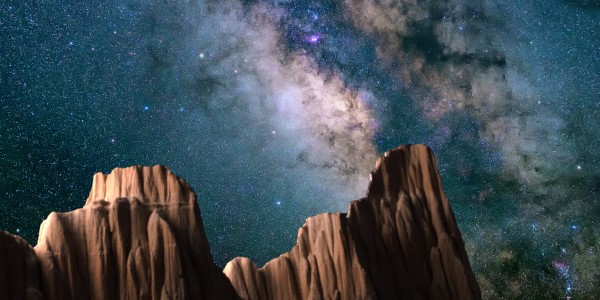In the heart of Colorado, partaking in a sleigh ride offers more than just a winter excursion. It encapsulates an experience of warmth and comfort. Experience cozy blankets, the crisp winter air, and melodious jingle bells. Sleigh rides transcend mere outdoor adventures. They unfold into elegant affairs featuring sumptuous dinners, the finest local Colorado wines, and the comforting ambiance of roaring fires. Continue reading for two of the most popular winter sleigh rides in Colorado. Also, if you are looking for a horse property for sale in Colorado, contact Colorado Horse Property today and speak with one of our horse-person realtors.
November Ski Season in Colorado
November in Colorado heralds the eager anticipation of winter’s arrival. As the season transitions from pavement to snow, the focus shifts. We focus more on activities that warm the spirit and embrace the impending cold. November is a quieter month for tourism, as many are preparing for the holiday season. However, it still offers a wealth of enjoyable pursuits, like skiing. Continue reading for more information on the November ski season in Colorado. Also, if you are looking for a horse property for sale in Colorado, contact Colorado Horse Property today and speak with one of our horse-person realtors.
Your Guide to the November Ski Season
Colorado is home to over two dozen ski resorts. Each battle to be the first to open for the season. While Arapahoe Basin usually is the winner in this category, others don’t fall too far behind with openings happening in mid to late November. Of course, this is always weather dependent. Some of the most popular areas are slated to open this month. This includes skiing areas like Beaver Creek, Breckenridge, Crested Butte and Copper Mountain. Copper Mountain in particular is a popular area for many out-of-state fall visitors.
Copper Mountain, nestled in the heart of the Rocky Mountains in Colorado, is a premier destination for outdoor enthusiasts and winter sports aficionados. This stunning alpine resort offers a wealth of recreational opportunities year-round, from world-class skiing and snowboarding on its diverse terrain to hiking, mountain biking, and golfing during the warmer months. Copper Mountain’s charming village boasts a vibrant atmosphere with a variety of shops, restaurants, and entertainment options. Copper Mountain has an elevation of 9,712 feet. Also, the area sees an average annual snowfall of over 280 inches. The Copper Mountain resort provides a snowy playground for these spectacular winter adventurers. Whether you’re seeking the thrill of the slopes or the tranquility of the mountain scenery, Copper Mountain has something to offer every visitor.
Horseback Riding in the Fall
As the vibrant colors of autumn begin to adorn the landscape, horse enthusiasts eagerly anticipate the chance to ride amidst the fall beauty. However, this season comes with its unique challenges, including colder temperatures, rain, and slippery terrain. To ensure you’re safe horseback riding in the Fall, it’s essential to be prepared and take certain precautions. Also, if you are looking for a horse property for sale in Colorado, contact Colorado Horse Property today and speak with one of our horse-person realtors.
Precautions for Horseback Riding in the Fall
One of the most noticeable challenges of riding in the fall is the drop in temperatures, especially during the mornings and evenings. To mitigate the effects of colder weather, riders can consider the following safety measures. Dressing in layers is a practical approach to staying warm. Start with a moisture-wicking base layer to keep sweat away from your skin, add an insulating layer for warmth, and finish with a windproof and waterproof outer layer. You should also protect your horse from the cold temperatures. Utilize horse blankets to help maintain body warmth and prevent chills in your horse.
Autumn often brings rain, which can create muddy and slippery conditions, posing additional challenges for riders. Invest in waterproof or water-resistant riding gear, including rainproof jackets and pants, to keep both yourself and your horse dry. For slippery terrain, consider attaching studs or ice calks to your horse’s horseshoes to provide better traction. There are also boots available that can offer additional grip. Reduce your riding speed in wet and slippery conditions, allowing your horse to maintain balance and prevent falls.
Capturing the Beauty of Horses
Horses, with their grace and majesty, have long been a captivating subject for photographers. Their beauty and power make them ideal candidates for stunning photography, but capturing that beauty in a still image can be a challenge. Successful horse photography requires a combination of technical skill, a deep understanding of equine behavior, and an artistic eye. Continue reading for techniques for capturing the beauty of horses in photos. Also, if you are looking for a horse property for sale in Colorado, contact Colorado Horse Property today and speak with one of our horse-person realtors.
Photographing The Beauty of Horses
Successful horse photography starts with observation. Take the time to watch the horses in their natural environment. Study their behavior, expressions, and movements. This will enable you to anticipate their actions and capture candid, authentic moments. Patience is key, as horses can be easily spooked, and it may take time to gain their trust. Also, light is one of the most critical elements in photography, and for horse photography, it’s no different. The golden hours of sunrise and sunset often provide the best lighting for capturing the beauty of horses. Soft, warm, directional light enhances the texture and color of the horse’s coat and creates a sense of depth. Avoid harsh midday sunlight, as it can cast unflattering shadows.
Pay attention to composition. Use the rule of thirds to create balanced and visually appealing images. Experiment with different angles and perspectives, such as getting down low for a dramatic ground-level view or capturing the horse against a scenic backdrop. Leading lines can draw the viewer’s eye towards the horse, creating a sense of movement and flow in the image. Also, selective focus is a powerful tool in horse photography. By using a wide aperture (e.g., f/2.8 or lower), you can isolate the horse from the background, creating a dreamy, bokeh-filled effect. Ensure that the horse’s eyes are sharp and in focus, as the eyes are the windows to the soul and can convey emotion.
How Horses Shaped the Harvest Season
As autumn approaches, we’re reminded of the historical significance of horses in agriculture during the fall harvest season. For centuries, horses shaped the harvest season by facilitating planting, tending, and reaping of crops. This essay delves into the historical importance of horses during the fall harvest and highlights their enduring role in modern agriculture. Also, if you are looking for a horse property for sale in Colorado, contact Colorado Horse Property today and speak with one of our horse-person realtors.
Horses Shaped the Harvest Season
In the past, the fall harvest was a time of great importance for agrarian societies. It marked the culmination of months of labor, careful cultivation, and anticipation. Horses were at the center of this agricultural endeavor, serving a multitude of critical roles. Farmers used horses to break and prepare the soil, pulling plows and tilling equipment to create the ideal planting environment. The reliable strength and speed of horses enabled the efficient sowing of seeds and planting of crops. From cultivating rows to pulling harrows, horses assisted in keeping the fields clear of weeds and properly aerated. Horses were invaluable during the harvest, whether for pulling grain binders to cut crops or for hauling loads of harvested produce. Horses also served as the primary mode of transportation to bring the harvested crops to storage or market.
While technology has revolutionized agriculture, horses have not been entirely replaced by tractors and machinery. In many regions worldwide, modern farmers continue to recognize the value of horses during the fall harvest season. Their role has evolved, but their significance remains. In small-scale or family farming, farmers still employ horses for various tasks, especially where the use of large machinery is not practical. The resurgence of interest in sustainable and organic farming has led to a reevaluation of traditional farming methods. Horses are great because of their minimal impact on the environment. Some agricultural operations require the precision and agility that horses can provide, such as vineyards and orchards. Horses also play a role in modern agriculture through equestrian tourism, providing riding experiences on farms or vineyards during the harvest season.
Horse Riding Age Limits
Horse owners with young children are often excited to introduce them to the horse world. But how early is too early? Are there horse riding age limits? Continue reading for some advice on this nuanced question and how to broach the subject with your family. Also, if you are looking for a horse property for sale in Colorado, contact Colorado Horse Property today and speak with one of our horse-person realtors.
Are There Horse Riding Age Limits?
Horseback riding is open to all ages and abilities. While there are no official guidelines, most riding schools and camps cater to children aged six and up. This is because a six-year-old is likely to be tall enough to sit safely on a full-sized horse. However, some instructors and riding schools have age limits that are based on their comfort level and the horses they have. These limits are often around nine years old. The physical abilities and health of the rider are more important than age. With proper supervision, children can start riding a smaller horse or pony as young as two or three years old. However, it’s important to consider that very young children benefit from riding early, but more for the enjoyment and sense of ease it gives them.
Consult any experienced rider, and they will emphasize the ongoing learning process. Even Olympic-level equestrians continuously partake in lessons and receive constant coaching. Proficient riders, too, engage in reading books and articles, seek regular instruction, and frequently attend clinics. Achieving excellence in riding demands the guidance of knowledgeable mentors and a trusted instructor. When considering introducing your child to riding, it’s important to assess their ability to concentrate on a task and follow instructions for at least 30 minutes. If they struggle to maintain focus for this duration, it might be advisable to wait until they are a bit older and more mature, as this ensures that your investment in their riding education is well-spent.
Fireproofing Your Horse Barn
Colorado is known for its dry climate. In fact, much of Colorado is designated as a high desert. Dry climates are a recipe for fires and Colorado has seen its fair share of this type of disaster. Horse owners have a lot at stake when it comes to facing fires. However, there are many things you can do to prevent fires from starting in your stables. Continue reading for some tips on fireproofing your horse barn. Also, if you are looking for a horse property for sale in Colorado, contact Colorado Horse Property today and speak with one of our horse-person realtors.
Tips on Fireproofing Your Horse Barn
There are several precautionary measures you can implement to reduce the risk of a fire starting in your horse barn. Firstly, ensure that any heat lamps or space heaters you use are positioned at a safe distance from flammable materials. Make sure to place these heating devices on stable, non-tipping surfaces. In terms of electrical safety, refrain from using extension cords within your barn. Regularly inspect your wiring for any signs of damage, and ensure that all electrical equipment is explicitly labeled for agricultural or commercial use. Installing protective covers for your lightbulbs is essential to shield them from dust, moisture, and breakage.
Since feed, hay, and straw are highly combustible, store them separately from your horses, ideally in a separate space or building. It is advisable to designate your barn as a smoke-free zone, following the guidance of your local fire department. Additionally, ensure that all individuals working in the barn know the proper use of fire extinguishers to swiftly respond to potential emergencies. If you need help fireproofing your barn or horse stables, contact your local fire department. Ask them if they have any resources that you can use to prevent a fire in your stables.
Wild Horses Are Good For The Environment
Did you know that wild horses are good for the environment? Wild horses, also known as mustangs in North America, play a vital role in promoting environmental health and biodiversity. Firstly, these magnificent creatures help control plant overgrowth through their grazing habits. By consuming various types of vegetation, wild horses can prevent the dominance of certain plant species. This promotes the growth of various plants. This natural grazing behavior can prevent the spread of invasive plant species. It also contributes to the overall balance of the ecosystem. Continue reading for more information. Also, if you are looking for a horse property for sale in Colorado, contact Colorado Horse Property today and speak with one of our horse-person realtors.
How Are Wild Horses Good For The Environment?
Wild horses help disperse seeds, inadvertently aiding in the regeneration of plant life. As they search for food and water, they carry seeds in their fur and digestive tracts. These seeds are subsequently deposited throughout their range. This assists in the natural reseeding of native plants and contributing to the overall biodiversity of the region. The presence of wild horses can enhance the landscape’s resilience to environmental changes. Their activities, such as digging for water in dry riverbeds or wallowing in mud holes, create small-scale disturbances that can serve as microhabitats for a variety of other wildlife. These disturbances can increase the overall habitat diversity and provide opportunities for smaller animals, birds, and insects to thrive in these unique niches.
In summary, wild horses play a valuable role in maintaining the health and diversity of their native ecosystems. Through their grazing habits, seed dispersal, and habitat modification, they contribute to the ecological balance and resilience of their environments, making them an integral part of the natural landscape. Efforts to protect and manage wild horse populations should take into account their positive impact on the environment and the broader ecological benefits they provide. Colorado is home to a bustling wild horse population.
What Does “Equine” Mean?
The word “equine” has its origins in Latin. It is derived from Latin meaning “pertaining to a horse”. The Latin word “equus” means “horse”. It is often used in English and other languages to describe things related to horses and horse-like creatures. Continue reading for more information on how we use this word in English. Also, if you are looking for a horse property for sale in Colorado, contact Colorado Horse Property today and speak with one of our horse-person realtors.
Answering The Question: What Does “Equine” Mean?
Equines include a relatively small number of species compared to some other animal families. There are three extant (currently living) equine species commonly recognized—horses, donkeys, and zebras. Horses are the most domesticated equine species. They come in various breeds. We use them for various purposes, including riding, racing, work, and companionship. Donkeys, also known as asses, are closely related to horses. Horses are hardy animals and we use them in agriculture and transportation, especially in regions with challenging terrain. Most people recognize zebras for their distinctive black and white striped coat patterns. There are several species of zebras, including the plains zebra, mountain zebra, and more. Unlike horses and donkeys, we typically find zebras in the wild. In other words, humans have not domesticated them to the same extent as other equines.
The term “equine” is also an adjective that pertains to or relates to horses, donkeys, and other animals of the horse family. It describes characteristics, attributes, or things associated with these animals. Equine anatomy refers to the study of the physical structure and body parts of horses and related animals. There is also equine behavior is the field of study that explores the behavior patterns, social interactions, and psychology of horses and equids. Equine industry is a term that describes the collective businesses and activities related to horses, including horse breeding, racing, riding, and more. Another big term is equine medicine. This is a branch of veterinary medicine, specifically for the health and medical care of horses and related species.
Colorado Stargazing
Due to Denver’s elevated altitude and arid climate, enthusiasts of the night sky can relish enhanced visibility. It is truly the premier urban center for stargazing. As a result, don’t forget to include these five stargazing spots in the vicinity of Denver on your must-visit list. Two of the best place near Denver for stargazing is the Red Rocks Amphitheater and Lookout Mountain Park. Continue reading for more information about these Colorado stargazing locations. Also, if you are looking for a horse property for sale in Colorado, contact Colorado Horse Property today and speak with one of our horse-person realtors.
Popular Colorado Stargazing Locations
Red Rocks Amphitheater offers more than just live performances and morning hikes; it’s also an excellent location for stargazing. Situated just a 25-minute drive away from Denver, some residual city light pollution exists. However you can still savor impressive views of the nighttime heavens while soaking in the splendor of Red Rocks. You can check out the Red Rocks website for upcoming performances this September throughout the rest of the year.
Located in Golden, Lookout Mountain Park, which is roughly a 35-minute drive from Denver, not only treats you to sweeping panoramas of the nearby terrain but also provides an unobstructed vantage point for observing the celestial expanse. Along Lookout Mountain Road or within the Lookout Mountain Park parking area, you can find suitable parking spots. This park gazes upon towering peaks in the northern direction and offers views of both the city of Golden and downtown Denver towards the east. Notably, both observation points are accessible to wheelchairs.


